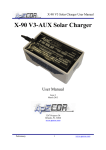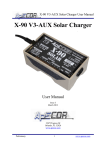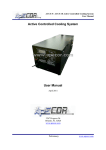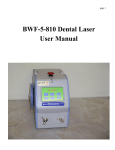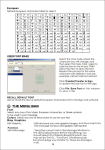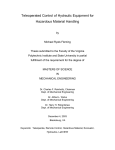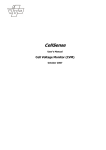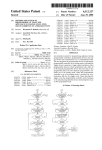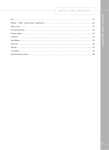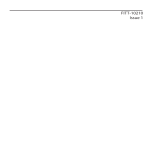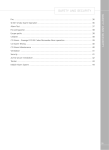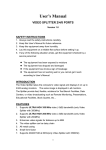Download X-90 Solar Charger User Manual 2010-06-23
Transcript
X-90 Solar Charger User Manual X-90 Solar Charger User Manual Issue 1 June 2010 3267 Progress Dr Orlando, FL 32826 www.apecor.com Preliminary www.apecor.com X-90 Solar Charger User Manual Table of Contents General Information........................................................................................................................ 3 Specification Summary............................................................................................................... 3 Safety .......................................................................................................................................... 3 Introduction................................................................................................................................. 3 What’s in the box? ...................................................................................................................... 4 Optional Accessories .................................................................................................................. 4 Solar Panel Selection & Input Power Considerations................................................................. 4 Battery Selection and Typical Operating Temperatures during Charging.................................. 4 Operation......................................................................................................................................... 5 Connection Configuration........................................................................................................... 5 Charging Procedures................................................................................................................... 7 General Considerations for Maximum Charging and Battery Performance............................... 7 Special Considerations for Charging BB-2590 Li-Ion Batteries ................................................ 7 Special Considerations for Charging BB-590 NiCd Batteries.................................................... 7 Special Considerations for Charging BB-390 NiMH Batteries.................................................. 7 Label on top of charger and LED Status Indicator ..................................................................... 8 Trouble Shooting ........................................................................................................................ 9 Maintenance................................................................................................................................ 9 Features ......................................................................................................................................... 10 Fast Maximum Power Point Tracking (MPPT) ........................................................................ 10 Reverse Polarity Protection (Electrically and Mechanically)................................................... 11 Temperature Protection............................................................................................................. 11 Over Current Protection............................................................................................................ 11 Technical Specifications ............................................................................................................... 12 Converter Efficiency................................................................................................................. 12 Maximum Output Current vs. Heatsink Temperature .............................................................. 13 Maximum Output Current vs. Input Voltage ............................................................................ 13 Maximum Output Current vs. Battery Temperature for BB-390 NiMH Batteries................... 14 Preliminary www.apecor.com X-90 Solar Charger User Manual General Information Specification Summary Maximum Input Voltage * Rated Charge Current Maximum Ambient Temperature * 60V 6A (total), 3A per battery string 60°C The solar panel’s open circuit voltage VOC must not exceed the maximum input voltage. Safety This manual contains important safety and operating instructions for the X-90 Solar Battery Charger. Read all the instructions and cautions of this manual and on the label of the X-90 before using it. To reduce the risk of electrical shock, fire, or injury operate charger in only the prescribed manner and use only with recommended items. General Safety Guidelines: • Only for BB-390 and BB-590 batteries: Do not remove the X-90 unit from a charging battery to “check the progress” by looking at the gas gauge of the battery. This will reset the algorithm, increasing the charge time, and potentially damage the battery. The X-90 unit will inform the user when the battery is fully charged. • Only use recommended accessories with the X-90. • Do not exceed the maximum input voltage and only charge recommended batteries, not doing so may result in fire, electrical shock, or injury. • Do not charge battery if the ambient temperature is outside of the recommended battery temperature limits. • Disconnect X-90 from panel by pulling on the plug, not the cord. • Do not use the X-90 with damaged cables or connector pins. • Check for proper electrical connections to the panel and battery to avoid excessive heating and power loss from a loose connection. • Do not try to operate the X-90 if any visible damages can be seen on it. • Make sure all contacts are clean before use. Introduction The X-90 Solar Charger is a portable solar battery charger capable of charging a wide array of typical portable rechargeable batteries. The charger features advanced digital control, which enables automatic battery detection, maximum power point tracking (MPPT) of the solar panel, and value-added features such as a fixed DC input mode. The charger is able to operate from any solar panel configuration with Vopen circuit < 60V. The charger directly plugs onto the top of the supported batteries, and the only wiring needed is the connection to the solar panel or DC source using a polarized SAE plug. The advanced charge controller minimizes charge time by charging two battery strings simultaneously, while monitoring critical parameters to ensure safety and reliability. The implementation of high-speed MPPT delivers maximum charging current, even in low light or poor weather conditions. The simple LED interface informs the user when the batteries have been completely charged, and if there are any fault conditions. Preliminary www.apecor.com X-90 Solar Charger User Manual What’s in the box? 1x X-90 Solar Charger, 1x 48” SAE Extension Cable, 1x SAE Y Parallel Cable Optional Accessories 1x Adapter to charge from another BB-x90 battery, 1x Adapter to charge from Lead-Acid batteries Solar Panel Selection & Input Power Considerations Use “12V” or “24V” solar panels or any other panel as long as its maximum power voltage (Vmp) is greater than 17V and its open circuit voltage (Voc) is below 60V. If available, the X-90 will use up to ~105W to charge a BB-2590 with its maximum rated charge current or ~65W for a BB-390 / BB-590. The included SAE Y cable can be used to parallel two solar panels in order to increase charge speed. There is no minimum input power requirement, only charge speed will decrease when used with lower power solar panels. A list of recommended panels is shown in Table 1 below. Company Global Solar Energy, Inc. Part # P3 62W 12V P3 62W 24V P3 55W 12V P3 48W 12V P3 48W 24V Max. Power @ 25°C 62W 62W 55W 48W 48W Nominal System Voltage 12V 24V 12V 12V 24V Table 1: Recommended Solar Panels Battery Selection and Typical Operating Temperatures during Charging Table 2 shows a list of BB-x90 batteries that can be charged with the X-90. Make sure that each battery is charged at its allowable ambient temperature range which is typically between 5°C (41°F) and 38°C (100°F). Refer to the label on each battery for exact values. Please note that the data sheet of most of the batteries lists only the operating and storage temperature ranges which are more extended and not the same as the charging temperature range! Company Mathews Associates, Inc. Bren-Tronics Patco Electronics Inc. UltraLife Batteries Part # BB-390A/U or BB-390/U BB-590/U BB-2590/U BB-2590/U BB-390B/U BB-590/U BB-2590/U UBBL02 (UBI-2590) UBBL10 (UBI-2590 SMBus) Chemistry NiMH NiCd Li-Ion Li-Ion NiMH NiCd Li-Ion Li-Ion Li-Ion Voltage 12.0/24.0 12.0/24.0 14.4/28.8 14.4/28.8 12.0/24.0 12.0/24.0 14.4/28.8 14.4/28.8 14.4/28.8 Table 2: Recommended Batteries Preliminary www.apecor.com X-90 Solar Charger User Manual Operation Connection Configuration There are basically two main methods to power the X-90 for charging the BB-x90 batteries: Solar panels (see Figure 1 and Figure 2) or a DC source such as other batteries (Figure 3 to Figure 5). The most common setup is with one solar panel connected. To increase charging speed or if clouds are limiting available power, solar panels can be paralleled. If available, the X-90 will use up to ~105W input power for BB-2590 batteries or up to ~65W for BB-390 and BB-590 batteries to charge them at their respective maximum charge currents. Other batteries can be used as power sources as long as they fulfill the input voltage and power requirements of the X-90. A 24V vehicle bus or two 12V lead-acid batteries in series could serve as a power source. Furthermore, if there is at least one partially discharged BB-x90 battery available, it could potentially be used to top off the BB-x90 of interest, so that at least one battery is fully charged for a mission. Figure 1: Charger Setup 1 with one Solar Panel as power source Figure 2: Charger Setup 2 with two Solar Panels in parallel as power source Preliminary www.apecor.com X-90 Solar Charger User Manual Figure 3: Charger Setup 3 with one 24V Battery as power source * Figure 4: Charger Setup 4 with two 12V batteries in series as power source * Figure 5: Charger Setup 5 with one BB-x90 Battery as power source * * using optional accessories Preliminary www.apecor.com X-90 Solar Charger User Manual Charging Procedures Connect the X-90 to the power source to be used and the battery to be charged in any order. If LEDs on top of the charger are still lit up from a previous charge, wait until all lights are off before connecting to another battery. Once everything is connected together, the two green LEDs blink at different speeds meaning that the X-90 is analyzing the connected battery for about 5 seconds to determine its chemistry. If there was no fault, the “Status LED” will continue to blink and the other two LEDs would be off. The “85% Charged LED” only lights up when a BB-2590 (Li-Ion) is connected and its capacity reached about 85% of the total capacity. The charge is finished once both green LEDs (the “85% Charged LED” and the “Status LED”) are both on. Then the battery and/or power source can be disconnected or another battery can be charged. General Considerations for Maximum Charging and Battery Performance Align solar panel perpendicular to the sun and avoid shading of the panel whenever possible for maximum power. Move the X-90 with the battery in the shade wherever possible, especially at high ambient temperatures. Even though the X-90 won’t be damaged when exposed to full sun while charging, the battery has lower maximum temperature limits while being charged that are typically around 38°C (100°F). Special Considerations for Charging BB-2590 Li-Ion Batteries Besides the “Status LED” there is also a “85% Charged LED” for BB-2590 batteries. It will light up once approximately 85% of the battery’s full capacity is reached. To charge the last 15% it will take about 30 to 40% of the total charge time! If there are more batteries to be charged, it makes sense to take off the current battery and to charge another fully depleted BB-2590 which could be charged to ~50% in the same time. This allows the user to have a higher overall state of charge for all the batteries instead of only having one battery completely charged. Special Considerations for Charging BB-590 NiCd Batteries The BB-590 battery is the hardest to accurately be charged to its full capacity using a variable power source such as a solar panel. In order to use the full potential of the charge algorithm implemented in the X-90, the following things have to be considered: • Don’t charge a battery if it is already known to be full. In some conditions a fully-charged battery might overheat if charged again. If possible, record the date of the last full charge of the battery and use it before recharging again. • If possible, discharge the two battery strings inside the BB-590 equally. Don’t repeatedly unplug the X-90 and connect it back to the battery. Those conditions might confuse the X-90 and it might terminate the charge too early. Special Considerations for Charging BB-390 NiMH Batteries The BB-390 has an internal temperature sensor which allows the X-90 to charge the battery more accurately and protect it from over-charge. Prior charge, the battery should be kept in a cool place because the charge cannot be started if its temperature is already above 40°C (104°F) in order to protect the battery from over-temperature. Therefore it is also not recommended to repeatedly unplug the X-90 from the battery and put it back on only to see the state-of-charge display. This is because once the battery’s temperature during charge is above 40°C (104°F) the X-90 will not start charging the battery again unless its temperature has dropped below that point. Preliminary www.apecor.com X-90 Solar Charger User Manual Label on top of charger and LED Status Indicator Red LED Green LED 1 Green LED 2 Figure 6: Label on top of charger and LED location Off Green LED 1 Off Blinking slowly Off Off (1) On (1) Off On Blinking - On - Red LED Off Off Green LED 2 Off Blinking quickly Blinking Meaning Action to take Ready to connect Analyzing battery chemistry Charging Connect battery - Optional: Disconnect battery and connect a lower charged Charging, battery battery. In the time it takes to charge the last 15%, the first Blinking (1) is 85% full (1) 50% of an empty battery could be charged. (1) On Finished charging Disconnect battery Temporary Fault The X-90 is always trying to reset faults. Keep an eye on condition the X-90 since it might not be able to clear the current fault which would lead to a latched fault. Latched Fault, Check connections, make sure that operation of converter converter not is within the maximum ratings, unplug and plug in again running battery and source Table 3: Meaning of LED status information Notes: Only applies when charging Li-Ion (1) Preliminary www.apecor.com X-90 Solar Charger User Manual Trouble Shooting Condition No lights on Fault light blinking for a longer period of time Condition X-90 finishes charge but state-of-charge display doesn’t show all 5 bars 85% light turning on and off Possible Causes X-90 ready to be connected to battery No or very little input power available Solutions Connect to battery to charge Check connection to solar panel Wait for more sunshine Orient panel perpendicular to sun Input power may be low Wait for more sunshine Orient panel perpendicular to sun Table 4: General Trouble Shooting Possible Causes The X-90 might have stopped early because of changing input power Internal battery gauge not accurate Solutions Unplug X-90 from the battery and plug back onto it to top off battery A full discharge and charge cycle of the battery might recalibrate the gauges Available power changes a lot while This is normal, no action needs to be battery is about 85% done taken Table 5: Trouble Shooting for BB-2590 (Li-Ion) Condition There is no power available from battery after finished charging Possible Causes Battery was charged at higher temperatures than recommended which triggered an internal safety switch Condition X-90 finishes charge but state-of-charge display doesn’t show all 5 bars Possible Causes The battery hasn’t been discharged completely for a longer period of time which causes offsets Battery temperature got too high because ambient temperature was above 38°C (100°F), therefore charge was terminated early to protect the battery Temperature of battery is above 40°C (104°F) Fault light blinking Solutions Let battery cool down, after a while power will be available again Make sure that battery is not being charged beyond recommended charging temperatures Table 6: Trouble Shooting for BB-590 (NiCd) Solutions Discharge battery completely before charging again Find a cool and ventilated place to charge the battery (Battery temperature needs to be below 40°C (104°F) for the X-90 to start charging again) Leave X-90 connected while battery cools down, X-90 will start charging battery once temperature is okay Table 7: Trouble Shooting for BB-390 (NiMH) Maintenance The X-90 has no serviceable parts. Check for broken, corroded, or otherwise damaged cable or battery contacts. Make sure that all battery contacts are straight and that the three smaller pins can be pushed in and come out again if released. If a defect has been found, replace the X-90. The cable to the solar panel may be repaired; however do NOT attempt to repair battery contacts. Make sure that all contacts are free of mud, dirt, dust, oil and grease. If found dirty, they can be cleaned with a damp non-abrasive cloth and allowed to air dry or wiped with a clean dry non-abrasive cloth. In case of oils and grease, use a mild soap/water solution to dampen the cloth. Preliminary www.apecor.com X-90 Solar Charger User Manual Features The X-90 has many features that enhance its core functions, make it safer to operate and increase its reliability. Fast Maximum Power Point Tracking (MPPT) A solar panel has a unique characteristic that is derived from the fact that as more current is drawn from the solar panel the more the voltage will decrease. The respective curves (IV – Current vs. Voltage, PV – Power vs. Voltage) in Figure 7 show that at a certain voltage the available power has a maximum. Typical battery chargers use the battery’s voltage to select where the solar panel is operating on the curve and this point of operation is mostly lower than the maximum power point (MPP). Figure 7: IV and PV curves for a typical solar panel The X-90 uses an advanced version of MPPT which is constantly running to make sure that it always operates at the MPP of the panel. This makes the X-90 superior to other MPPT battery chargers that look for the MPP every once in a while. This is because the X-90 finds the new MPP very quickly during changing conditions whereas other MPPT chargers don’t operate at the new MPP until their next scan. This is especially important during days with lots of clouds and wind which lead to fast variations in available power. Since the X-90 can operate longer at the maximum power than other chargers, it can charge the battery faster. The changes in available solar power reaching the panel is usually shading caused by objects blocking the sun such as clouds, people, or trees. If there is more power available from the solar panel than needed to charge the respective battery, then the X-90 will drop out of MPPT mode. This can happen for all batteries if there is a higher power solar panel connected or it could mean that the battery (only for BB-2590 batteries) is nearly full. Preliminary www.apecor.com X-90 Solar Charger User Manual Reverse Polarity Protection (Electrically and Mechanically) In order to protect the entire system the X-90 has a reverse polarity protection (RPP) on the solar panel and battery side. If there is no positive voltage seen on the terminals of the X-90, it won’t allow any current to flow, which is the electrical RPP. In addition, there is a mechanical RPP which means that the solar panel and battery cannot be plugged in the wrong way. Temperature Protection The X-90 provides the full charge current up to a certain internal temperature. After that it will linearly de-rate the charge current up to a maximum allowable internal temperature in order to protect its circuitry to safe limits. For the respective graph, refer to Figure 9 in paragraph Technical Specifications. Over Current Protection The X-90 is protected against over-current and short circuit conditions. Normally, it will limit the maximum charge current to ~3A for a BB-2590 battery or to ~2A for a BB-390 / BB-590 battery. If under some condition the current still comes up higher, a fault may be triggered. After that, the software of the X-90 can successfully reset the fault in case it was only temporarily. If the high current could not be stopped because the circuitry of the X-90 is damaged, an internal fuse will break and disconnect from the battery. In that case the X-90 would be permanently non-operational. This behavior is preferred, as the battery is protected from short circuit currents that could have led to a catastrophic failure of the battery. Preliminary www.apecor.com X-90 Solar Charger User Manual Technical Specifications Converter Efficiency Figure 8 shows typical efficiency numbers of the X-90 as a function of total output current with three different input voltages and with an output (battery) voltage of ~15V at 25°C (77°F) ambient temperature. The 20V input voltage case represents the maximum power voltage of a “12V” solar panel whereas 40V represents the maximum power voltage of a “24V” solar panel, both at 25°C (77°F) panel temperature. X-90 Solar Efficiencies 98 96 94 Efficiency (%) 92 90 20V input voltage 40V input voltage 88 86 84 82 80 0 0.5 1 1.5 2 2.5 3 3.5 4 4.5 5 5.5 6 Total Output Current (Amps) Figure 8: X-90 Efficiencies When charging a particular BB-x90 battery with a certain solar panel and at a particular power level, the X-90 operates at certain points on the efficiency curve. Some configuration examples can be seen in Table 8; the last column then shows the expected converter efficiency for each case. Battery BB-2590 BB-2590 BB-2590 BB-2590 BB-590 / BB-390 BB-590 / BB-390 BB-590 / BB-390 BB-590 / BB-390 Panel System Maximum Power Charge Current Current per Voltage Voltage of Panel Level Battery String 12V 20V Full current 3A 24V 40V Full current 3A 12V 20V Half current 1.5A 24V 40V Half current 1.5A 12V 20V Full current 2A 24V 40V Full current 2A 12V 20V Half current 1A 24V 40V Half current 1A Table 8: Typical X-90 Efficiencies while charging BB-x90 batteries Preliminary X-90 Efficiency 95.3% 95.7% 97.1% 96.4% 96.6% 96.5% 97.1% 96% www.apecor.com X-90 Solar Charger User Manual Maximum Output Current vs. Heatsink Temperature BB-2590 BB-390 / BB-590 Max. Output Current / Battery String (Amps) 3.5 3 2.5 2 1.5 1 0.5 0 70 75 80 85 90 95 100 Heatsink Temperature (°C) Figure 9: Max. Output Current per Battery String vs. Internal Heatsink Temperature Maximum Output Current vs. Input Voltage BB-2590 BB-390 / BB-590 Max. Output Current / Battery String (Amps) 3.5 3 2.5 2 1.5 1 0.5 0 30 35 40 45 50 55 60 Input Voltage (V) Figure 10: Max. Output Current per Battery String vs. Input Voltage Preliminary www.apecor.com X-90 Solar Charger User Manual Maximum Output Current vs. Battery Temperature for BB-390 NiMH Batteries Max. Output Current / Battery String (Amps) 2.5 2 1.5 1 0.5 0 -5 0 5 10 15 20 25 30 35 40 45 50 BB-390 Battery Temperature (°C) Figure 11: Max. Output Current per Battery String vs. BB-390 Battery Temperature For further technical information please consult the datasheet of the X-90 Solar Charger. Preliminary www.apecor.com














